Paper Menu >>
Journal Menu >>
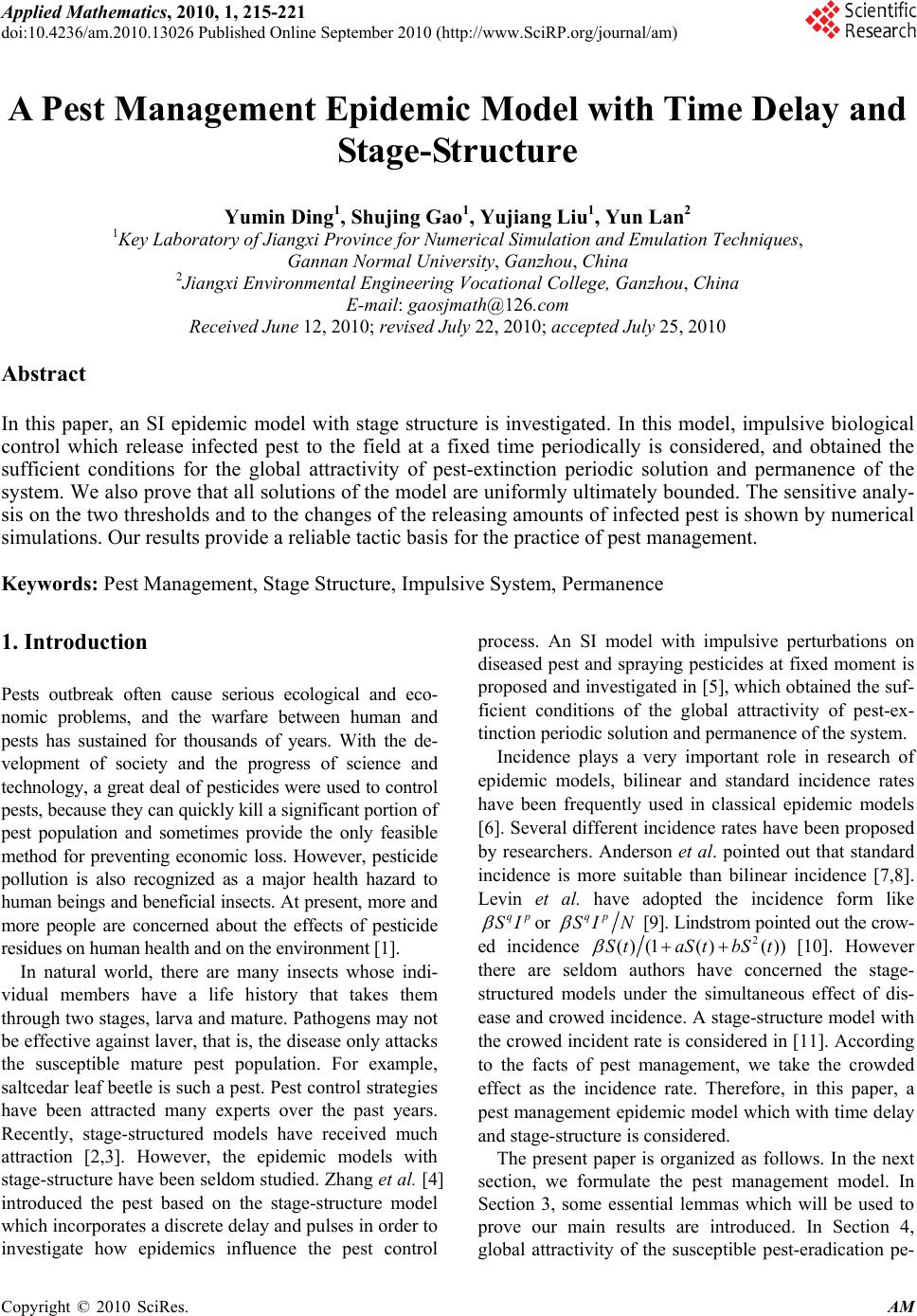 Applied Mathematics, 2010, 1, 215-221 doi:10.4236/am.2010.13026 Published Online September 2010 (http://www.SciRP.org/journal/am) Copyright © 2010 SciRes. AM A Pest Management Epidemic Model with Time Delay and Stage-Structure Yumin Ding1, Shujing Gao1, Yujiang Liu1, Yun Lan2 1Key Laboratory of Jiangxi Province for Numerical Simulation and Emulation Techniques, Gannan Normal University, Ganzhou, China 2Jiangxi Environmental Engineering Vocational College, Ganzhou, China E-mail: gaosjmath@126.com Received June 12, 2010; revised July 22, 2010; accepted July 25, 2010 Abstract In this paper, an SI epidemic model with stage structure is investigated. In this model, impulsive biological control which release infected pest to the field at a fixed time periodically is considered, and obtained the sufficient conditions for the global attractivity of pest-extinction periodic solution and permanence of the system. We also prove that all solutions of the model are uniformly ultimately bounded. The sensitive analy- sis on the two thresholds and to the changes of the releasing amounts of infected pest is shown by numerical simulations. Our results provide a reliable tactic basis for the practice of pest management. Keywords: Pest Management, Stage Structure, Impulsive System, Permanence 1. Introduction Pests outbreak often cause serious ecological and eco- nomic problems, and the warfare between human and pests has sustained for thousands of years. With the de- velopment of society and the progress of science and technology, a great deal of pesticides were used to control pests, because they can quickly kill a significant portion of pest population and sometimes provide the only feasible method for preventing economic loss. However, pesticide pollution is also recognized as a major health hazard to human beings and beneficial insects. At present, more and more people are concerned about the effects of pesticide residues on human health and on the environment [1]. In natural world, there are many insects whose indi- vidual members have a life history that takes them through two stages, larva and mature. Pathogens may not be effective against laver, that is, the disease only attacks the susceptible mature pest population. For example, saltcedar leaf beetle is such a pest. Pest control strategies have been attracted many experts over the past years. Recently, stage-structured models have received much attraction [2,3]. However, the epidemic models with stage-structure have been seldom studied. Zhang et al. [4] introduced the pest based on the stage-structure model which incorporates a discrete delay and pulses in order to investigate how epidemics influence the pest control process. An SI model with impulsive perturbations on diseased pest and spraying pesticides at fixed moment is proposed and investigated in [5], which obtained the suf- ficient conditions of the global attractivity of pest-ex- tinction periodic solution and permanence of the system. Incidence plays a very important role in research of epidemic models, bilinear and standard incidence rates have been frequently used in classical epidemic models [6]. Several different incidence rates have been proposed by researchers. Anderson et al. pointed out that standard incidence is more suitable than bilinear incidence [7,8]. Levin et al. have adopted the incidence form like qp SI or qp SI N [9]. Lindstrom pointed out the crow- ed incidence 2 () (1()() ) StaStbS t [10]. However there are seldom authors have concerned the stage- structured models under the simultaneous effect of dis- ease and crowed incidence. A stage-structure model with the crowed incident rate is considered in [11]. According to the facts of pest management, we take the crowded effect as the incidence rate. Therefore, in this paper, a pest management epidemic model which with time delay and stage-structure is considered. The present paper is organized as follows. In the next section, we formulate the pest management model. In Section 3, some essential lemmas which will be used to prove our main results are introduced. In Section 4, global attractivity of the susceptible pest-eradication pe- 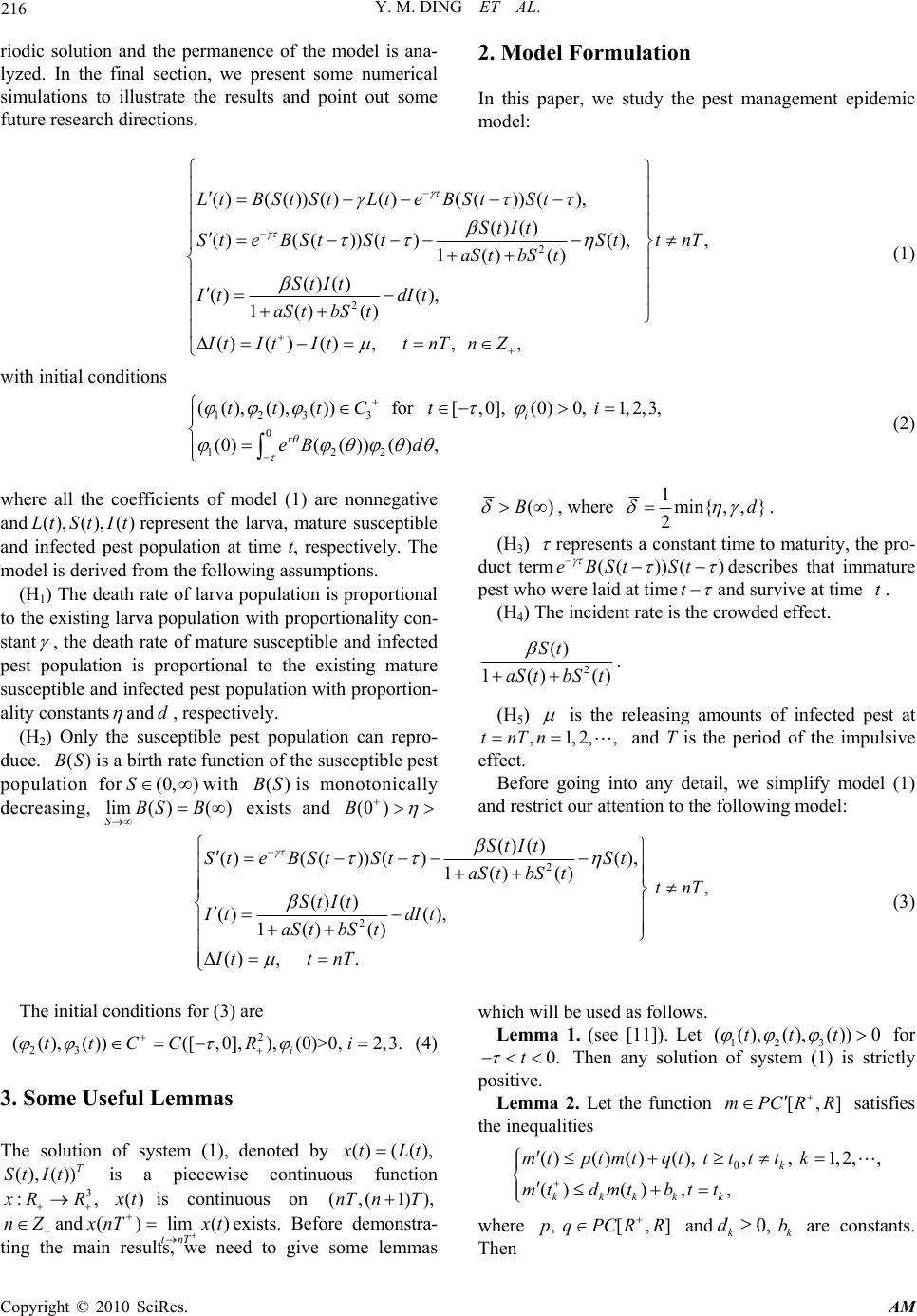 Y. M. DING ET AL. Copyright © 2010 SciRes. AM 216 riodic solution and the permanence of the model is ana- lyzed. In the final section, we present some numerical simulations to illustrate the results and point out some future research directions. 2. Model Formulation In this paper, we study the pest management epidemic model: 2 2 ()( ()) ()()( ()) (), () () ()(())()(), , 1() () () () () (), 1() () ()()(), , , L tBStStLteBStSt StIt S teBStStSttnT aS tbSt StIt It dIt aS tbSt ItItIttnTnZ (1) with initial conditions 123 3 0 122 ((),(),()) for [,0], (0)0, 1,2,3, (0)(())( ), i r tttC ti eB d (2) where all the coefficients of model (1) are nonnegative and (),(),()LtStIt represent the larva, mature susceptible and infected pest population at time t, respectively. The model is derived from the following assumptions. (H1) The death rate of larva population is proportional to the existing larva population with proportionality con- stant , the death rate of mature susceptible and infected pest population is proportional to the existing mature susceptible and infected pest population with proportion- ality constants and d, respectively. (H2) Only the susceptible pest population can repro- duce. ()BSis a birth rate function of the susceptible pest population for(0, )Swith ()BSis monotonically decreasing, lim( )() SBS B exists and (0 )B ()B , where 1min{ ,,} 2d . (H3) represents a constant time to maturity, the pro- duct term(( ))( )eBStSt describes that immature pest who were laid at timet and survive at time t. (H4) The incident rate is the crowded effect. 2 () 1() () St aS tbSt . (H5) is the releasing amounts of infected pest at ,1,2,,tnTn and T is the period of the impulsive effect. Before going into any detail, we simplify model (1) and restrict our attention to the following model: 2 2 () () ()( ()) ()(), 1() (), () () () (), 1() () (), . StIt S teBStStSt aS tbSttnT StIt It dIt aS tbSt Itt nT (3) The initial conditions for (3) are 2 23 ((),())([,0],),(0)>0, 2,3. i ttCC Ri (4) 3. Some Useful Lemmas The solution of system (1), denoted by ()( (), x tLt (), ()) T St It is a piecewise continuous function 3 :, x RR () x tis continuous on (,(1)),nT nT nZ and ()lim() tnT x nTx t exists. Before demonstra- ting the main results, we need to give some lemmas which will be used as follows. Lemma 1. (see [11]). Let 123 ((),(), ()) 0ttt for 0.t Then any solution of system (1) is strictly positive. Lemma 2. Let the function [,]mPCRR satisfies the inequalities 0 ()()()(), ,, 1,2,, ()() ,, k kkkkk mtptmtqtt ttt k mtdmtb tt where , [,]pqPCR R and0, k dk b are constants. Then 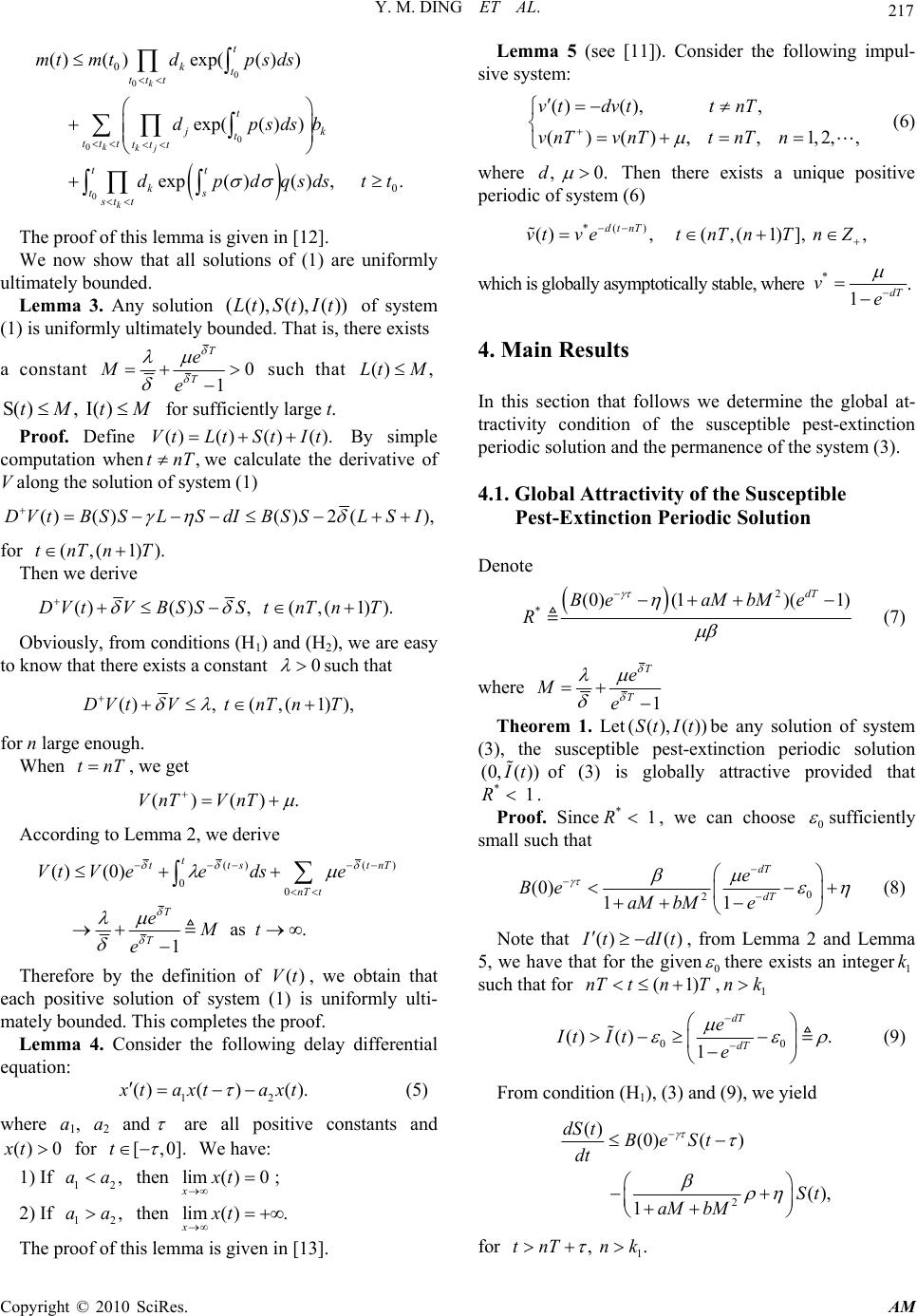 Y. M. DING ET AL. Copyright © 2010 SciRes. AM 217 0 0 0 0 0 0 0 ()()exp(( )) exp(()) exp()(), . k kkj k t kt ttt t jk t tttttt tt k ts stt mt mtdpsds dpsdsb dpdqsdstt The proof of this lemma is given in [12]. We now show that all solutions of (1) are uniformly ultimately bounded. Lemma 3. Any solution (( ),( ),( ))Lt St It of system (1) is uniformly ultimately bounded. That is, there exists a constant 0 1 T T e Me such that () ,LtM S(), I()tMtM for sufficiently large t. Proof. Define ()()() ().VtLt StIt By simple computation when,tnTwe calculate the derivative of V along the solution of system (1) ()()() 2(),DVtBSSLS dIBSSLSI for (,( 1)).tnTn T Then we derive ()(), (,(1)). DVtVBSSStnT nT Obviously, from conditions (H1) and (H2), we are easy to know that there exists a constant 0 such that (), (,(1)),DV tVtnTnT for n large enough. When tnT, we get ()().VnT VnT According to Lemma 2, we derive ()( ) 00 () (0) as . 1 t tts tnT nT t T T Vt Veedse eMt e Therefore by the definition of ()Vt , we obtain that each positive solution of system (1) is uniformly ulti- mately bounded. This completes the proof. Lemma 4. Consider the following delay differential equation: 12 ()( )(). x taxt axt (5) where a1, a2 and are all positive constants and () 0xt for [,0].t We have: 1) If 12 ,aa then lim()0 ; xxt 2) If 12 ,aa then lim( ). xxt The proof of this lemma is given in [13]. Lemma 5 (see [11]). Consider the following impul- sive system: ()(), , ()(),,1,2,, vtdv ttnT vnTvnTt nTn (6) where , 0.d Then there exists a unique positive periodic of system (6) *() (), (,(1)], , dt nT vtvetnT nTnZ which is globally asymptotically stable, where * 1dT ve . 4. Main Results In this section that follows we determine the global at- tractivity condition of the susceptible pest-extinction periodic solution and the permanence of the system (3). 4.1. Global Attractivity of the Susceptible Pest-Extinction Periodic Solution Denote 2 *(0)(1)( 1) dT Be aMbMe R (7) where 1 T T e Me Theorem 1. Let((),())St Itbe any solution of system (3), the susceptible pest-extinction periodic solution (0,( )) I t of (3) is globally attractive provided that *1R . Proof. Since*1R , we can choose 0 sufficiently small such that 0 2 (0) 11 dT dT e Be aM bMe (8) Note that () () I tdIt , from Lemma 2 and Lemma 5, we have that for the given0 there exists an integer1 k such that for (1)nT tnT ,1 nk 00 () (). 1 dT dT e It Ite (9) From condition (H1), (3) and (9), we yield 2 () (0)( ) (), 1 dS tBeSt dt St aM bM for 1 , .tnTnk 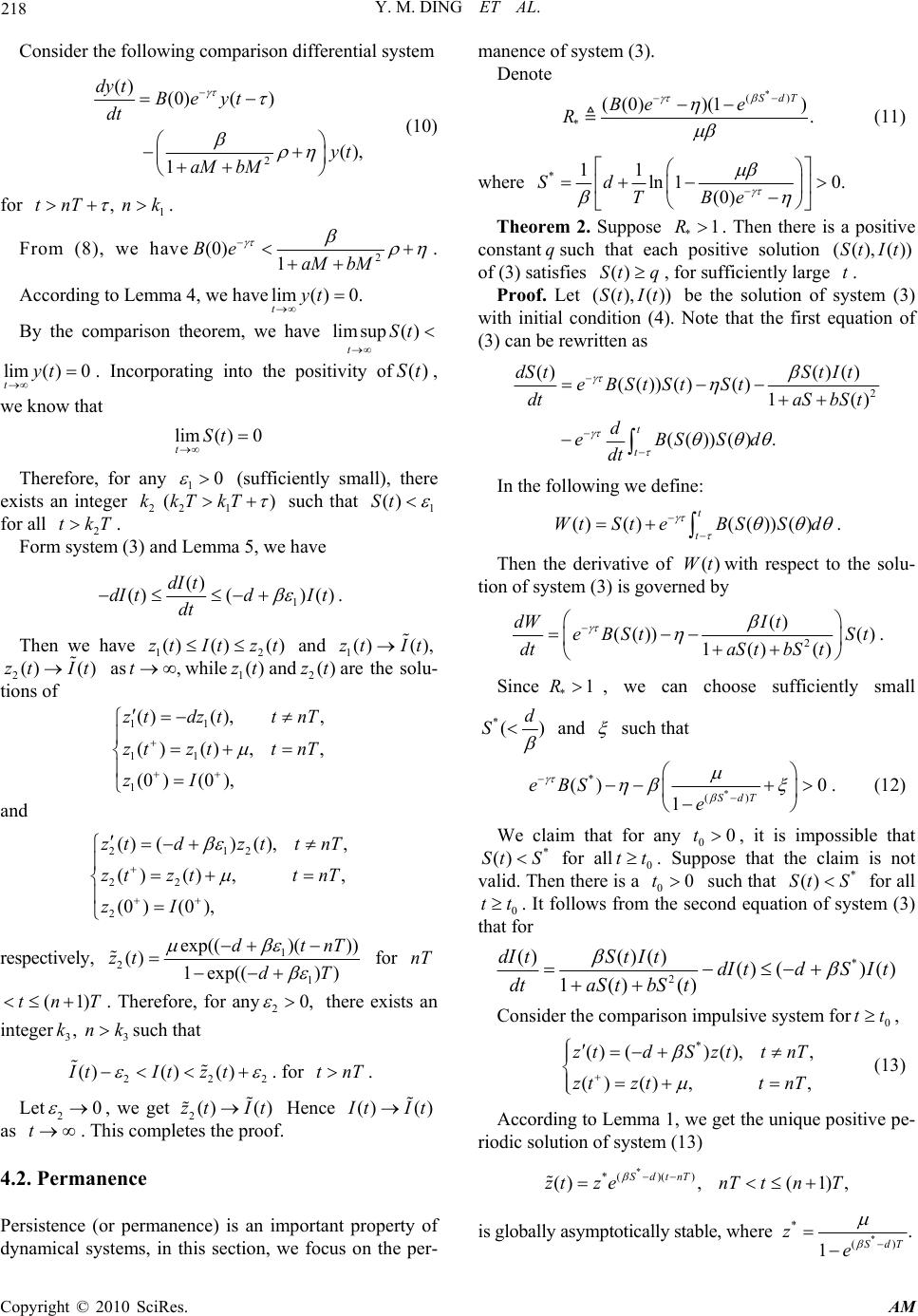 Y. M. DING ET AL. Copyright © 2010 SciRes. AM 218 Consider the following comparison differential system 2 () (0)( ) (), 1 dy tBeyt dt yt aM bM (10) for 1 , tnT nk . From (8), we have2 (0) 1 Be aM bM . According to Lemma 4, we havelim()0. tyt By the comparison theorem, we have lim sup() t St lim( )0 tyt . Incorporating into the positivity of()St , we know that lim( )0 tSt Therefore, for any 10 (sufficiently small), there exists an integer 22 1 ()kkTkT such that 1 ()St for all 2 tkT. Form system (3) and Lemma 5, we have 1 () ()() () dI t dI tdIt dt . Then we have 12 () ()()ztItz t and 1() (),zt It 2() ()zt It as,twhile 1()ztand2()ztare the solu- tions of 11 11 1 ()(), , ()(),, (0 )(0 ), ztdztt nT ztztt nT zI and 212 22 2 ()() (),, ()(), , (0 )(0 ), ztdzttnT ztztt nT zI respectively, 1 2 1 exp(()( )) () 1exp(()) dtnT zt dT for nT (1)tnT . Therefore, for any20, there exists an integer 3,k3 nksuch that 222 ()() ()ItItz t . for tnT. Let 20 , we get 2() ()zt It Hence ()() I tIt as t. This completes the proof. 4.2. Permanence Persistence (or permanence) is an important property of dynamical systems, in this section, we focus on the per- manence of system (3). Denote * () * ((0) )(1) . SdT Bee R (11) where *11 ln 10. (0) Sd TBe Theorem 2. Suppose *1R. Then there is a positive constant qsuch that each positive solution ((),())StIt of (3) satisfies ()St q, for sufficiently large t. Proof. Let ((),())St It be the solution of system (3) with initial condition (4). Note that the first equation of (3) can be rewritten as 2 ()() () ( ()) ()()1() (())(). t t dS tS tI t eBSt StSt dt aSbS t d eBSSd dt In the following we define: ()()(( ))( ) t t WtSt eBSS d . Then the derivative of ()Wt with respect to the solu- tion of system (3) is governed by 2 () (()) () 1() () dWI t eBSt St dt aS tbSt . Since *1R, we can choose sufficiently small *() d S and such that * * () () 0 1SdT eBS e . (12) We claim that for any 00t, it is impossible that * ()StS for all0 tt. Suppose that the claim is not valid. Then there is a 00t such that * ()St S for all 0 tt. It follows from the second equation of system (3) that for * 2 ()() ()()()() 1() () dI tStI tdI tdSI t dtaStbSt Consider the comparison impulsive system for0 tt, * ()() (),, ()(), , ztdS zttnT ztztt nT (13) According to Lemma 1, we get the unique positive pe- riodic solution of system (13) * *()( ) (), (1), SdtnT ztzenT tnT is globally asymptotically stable, where * * () 1SdT z e . 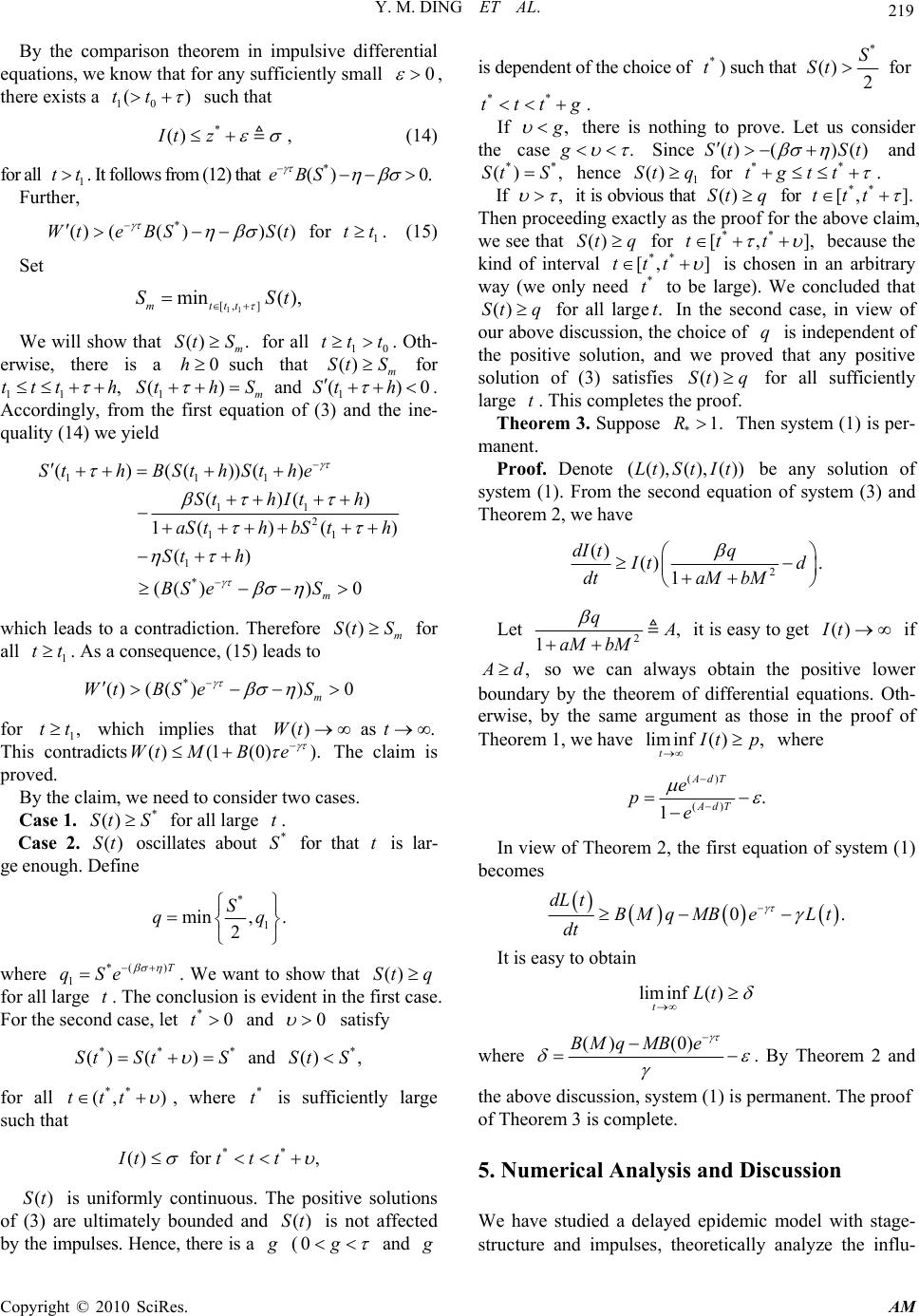 Y. M. DING ET AL. Copyright © 2010 SciRes. AM 219 By the comparison theorem in impulsive differential equations, we know that for any sufficiently small 0 , there exists a 10 ()tt such that * ()Itz , (14) for all 1 tt. It follows from (12) that * () 0eBS . Further, * ()(())()Wte BSSt for 1 tt. (15) Set 11 [, ] min( ), mttt SSt We will show that () . m St S for all 10 tt t. Oth- erwise, there is a 0hsuch that ()m St S for 11 ,ttth 1 () m SthS and 1 ()0Sth . Accordingly, from the first equation of (3) and the ine- quality (14) we yield 111 11 2 11 1 * ()(())() ()() 1( )( ) () (())0 m SthBSt hSthe St hIt h aSthbSth St h BS eS which leads to a contradiction. Therefore () m St S for all 1 tt. As a consequence, (15) leads to * ()( ())0 m Wt BSeS for 1,tt which implies that ()Wt as.t This contradicts()(1(0) ).Wt MBe The claim is proved. By the claim, we need to consider two cases. Case 1. * ()St S for all large t. Case 2. ()St oscillates about * S for that t is lar- ge enough. Define * 1 min, . 2 S qq where *( ) 1 T qSe . We want to show that ()St q for all large t. The conclusion is evident in the first case. For the second case, let *0t and 0 satisfy ** * () ()StStS and * () ,StS for all ** (, )ttt , where * t is sufficiently large such that ** () for ,Ittt t ()St is uniformly continuous. The positive solutions of (3) are ultimately bounded and ()St is not affected by the impulses. Hence, there is a g (0g and g is dependent of the choice of * t) such that * () 2 S St for ** tttg . If , g there is nothing to prove. Let us consider the case. g Since()() ()St St and ** () ,St S hence 1 ()St q for ** tgtt . If , it is obvious that ()St q for ** [, ].ttt Then proceeding exactly as the proof for the above claim, we see that ()Stq for ** [, ],tt t because the kind of interval ** [, ]ttt is chosen in an arbitrary way (we only need * t to be large). We concluded that ()St q for all large.t In the second case, in view of our above discussion, the choice of q is independent of the positive solution, and we proved that any positive solution of (3) satisfies ()St q for all sufficiently large t. This completes the proof. Theorem 3. Suppose *1.R Then system (1) is per- manent. Proof. Denote ((),(),())Lt St It be any solution of system (1). From the second equation of system (3) and Theorem 2, we have 2 () () . 1 dI tq I td dt aM bM Let 2, 1 q A aM bM it is easy to get ()It if , A d so we can always obtain the positive lower boundary by the theorem of differential equations. Oth- erwise, by the same argument as those in the proof of Theorem 1, we have lim inf(), t I tp where () () . 1 AdT AdT e pe In view of Theorem 2, the first equation of system (1) becomes 0. dL tBM qMBeLt dt It is easy to obtain lim inf() tLt where () (0)BM qMBe . By Theorem 2 and the above discussion, system (1) is permanent. The proof of Theorem 3 is complete. 5. Numerical Analysis and Discussion We have studied a delayed epidemic model with stage- structure and impulses, theoretically analyze the influ- 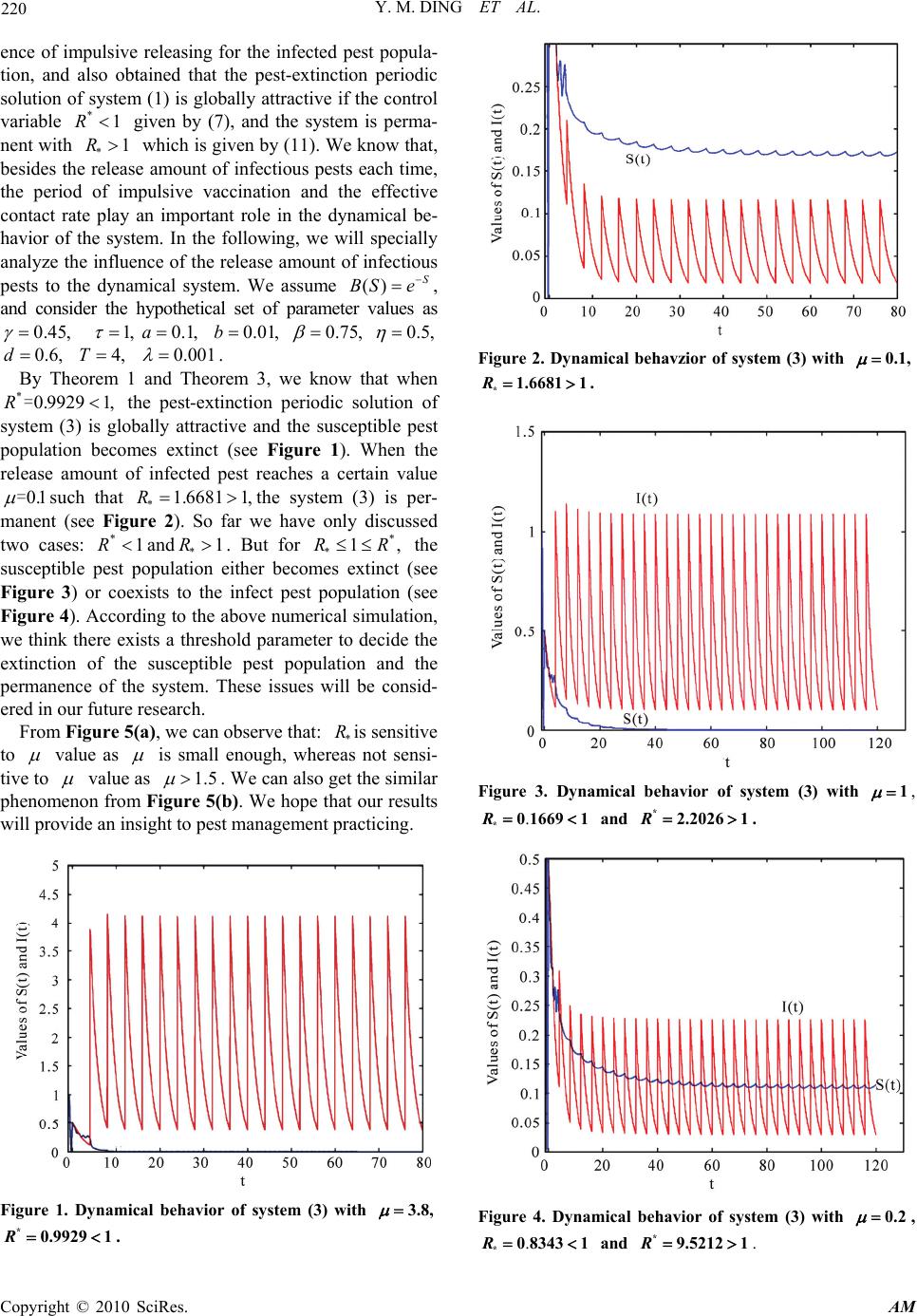 Y. M. DING ET AL. Copyright © 2010 SciRes. AM 220 ence of impulsive releasing for the infected pest popula- tion, and also obtained that the pest-extinction periodic solution of system (1) is globally attractive if the control variable *1R given by (7), and the system is perma- nent with *1R which is given by (11). We know that, besides the release amount of infectious pests each time, the period of impulsive vaccination and the effective contact rate play an important role in the dynamical be- havior of the system. In the following, we will specially analyze the influence of the release amount of infectious pests to the dynamical system. We assume ()S BSe , and consider the hypothetical set of parameter values as 0.45, 1, 0.1,a 0.01,b 0.75, 0.5, 0.6,d 4,T 0.001 . By Theorem 1 and Theorem 3, we know that when *0.9929 1,R= the pest-extinction periodic solution of system (3) is globally attractive and the susceptible pest population becomes extinct (see Figure 1). When the release amount of infected pest reaches a certain value 0.1 =such that *1.6681 1,Rthe system (3) is per- manent (see Figure 2). So far we have only discussed two cases: *1Rand *1R. But for * *1,RR the susceptible pest population either becomes extinct (see Figure 3) or coexists to the infect pest population (see Figure 4). According to the above numerical simulation, we think there exists a threshold parameter to decide the extinction of the susceptible pest population and the permanence of the system. These issues will be consid- ered in our future research. From Figure 5(a), we can observe that: * Ris sensitive to value as is small enough, whereas not sensi- tive to value as 1.5 . We can also get the similar phenomenon from Figure 5(b). We hope that our results will provide an insight to pest management practicing. Figure 1. Dynamical behavior of system (3) with 3.8, *0.9929 1R. Figure 2. Dynamical behavzior of system (3) with 0.1, *1.6681 1 R. Figure 3. Dynamical behavior of system (3) with 1 , . *0 16691 R and *2.20261 R. Figure 4. Dynamical behavior of system (3) with 0.2 , . *0 83431 R and *9.5212 1 R. 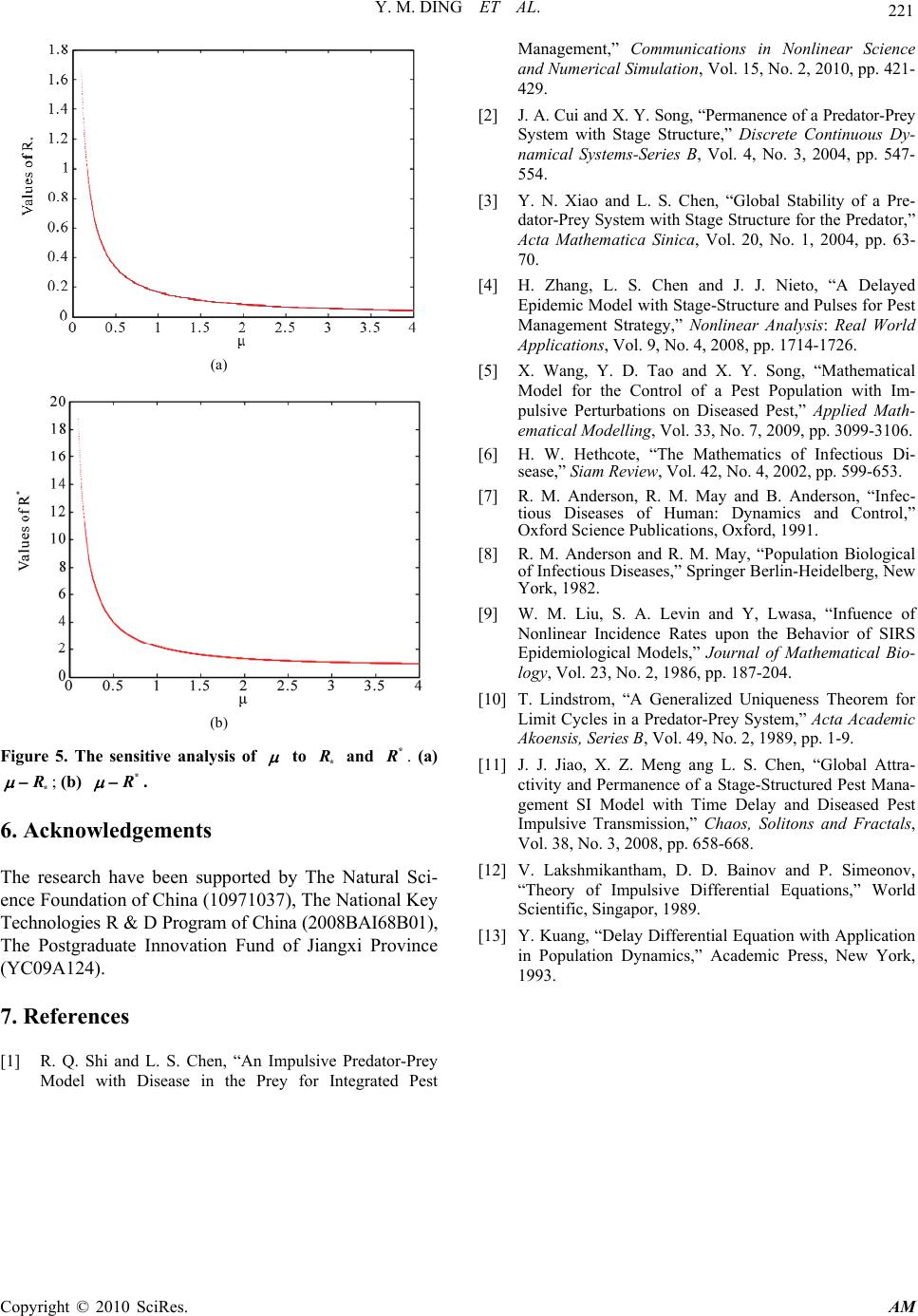 Y. M. DING ET AL. Copyright © 2010 SciRes. AM 221 (a) (b) Figure 5. The sensitive analysis of to * R and * R . (a) * R ; (b) * R . 6. Acknowledgements The research have been supported by The Natural Sci- ence Foundation of China (10971037), The National Key Technologies R & D Program of China (2008BAI68B01), The Postgraduate Innovation Fund of Jiangxi Province (YC09A124). 7. References [1] R. Q. Shi and L. S. Chen, “An Impulsive Predator-Prey Model with Disease in the Prey for Integrated Pest Management,” Communications in Nonlinear Science and Numerical Simulation, Vol. 15, No. 2, 2010, pp. 421- 429. [2] J. A. Cui and X. Y. Song, “Permanence of a Predator-Prey System with Stage Structure,” Discrete Continuous Dy- namical Systems-Series B, Vol. 4, No. 3, 2004, pp. 547- 554. [3] Y. N. Xiao and L. S. Chen, “Global Stability of a Pre- dator-Prey System with Stage Structure for the Predator,” Acta Mathematica Sinica, Vol. 20, No. 1, 2004, pp. 63- 70. [4] H. Zhang, L. S. Chen and J. J. Nieto, “A Delayed Epidemic Model with Stage-Structure and Pulses for Pest Management Strategy,” Nonlinear Analysis: Real World Applications, Vol. 9, No. 4, 2008, pp. 1714-1726. [5] X. Wang, Y. D. Tao and X. Y. Song, “Mathematical Model for the Control of a Pest Population with Im- pulsive Perturbations on Diseased Pest,” Applied Math- ematical Modelling, Vol. 33, No. 7, 2009, pp. 3099-3106. [6] H. W. Hethcote, “The Mathematics of Infectious Di- sease,” Siam Review, Vol. 42, No. 4, 2002, pp. 599-653. [7] R. M. Anderson, R. M. May and B. Anderson, “Infec- tious Diseases of Human: Dynamics and Control,” Oxford Science Publications, Oxford, 1991. [8] R. M. Anderson and R. M. May, “Population Biological of Infectious Diseases,” Springer Berlin-Heidelberg, New York, 1982. [9] W. M. Liu, S. A. Levin and Y, Lwasa, “Infuence of Nonlinear Incidence Rates upon the Behavior of SIRS Epidemiological Models,” Journal of Mathematical Bio- logy, Vol. 23, No. 2, 1986, pp. 187-204. [10] T. Lindstrom, “A Generalized Uniqueness Theorem for Limit Cycles in a Predator-Prey System,” Acta Academic Akoensis, Series B, Vol. 49, No. 2, 1989, pp. 1-9. [11] J. J. Jiao, X. Z. Meng ang L. S. Chen, “Global Attra- ctivity and Permanence of a Stage-Structured Pest Mana- gement SI Model with Time Delay and Diseased Pest Impulsive Transmission,” Chaos, Solitons and Fractals, Vol. 38, No. 3, 2008, pp. 658-668. [12] V. Lakshmikantham, D. D. Bainov and P. Simeonov, “Theory of Impulsive Differential Equations,” World Scientific, Singapor, 1989. [13] Y. Kuang, “Delay Differential Equation with Application in Population Dynamics,” Academic Press, New York, 1993. |

